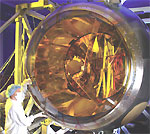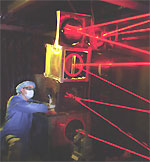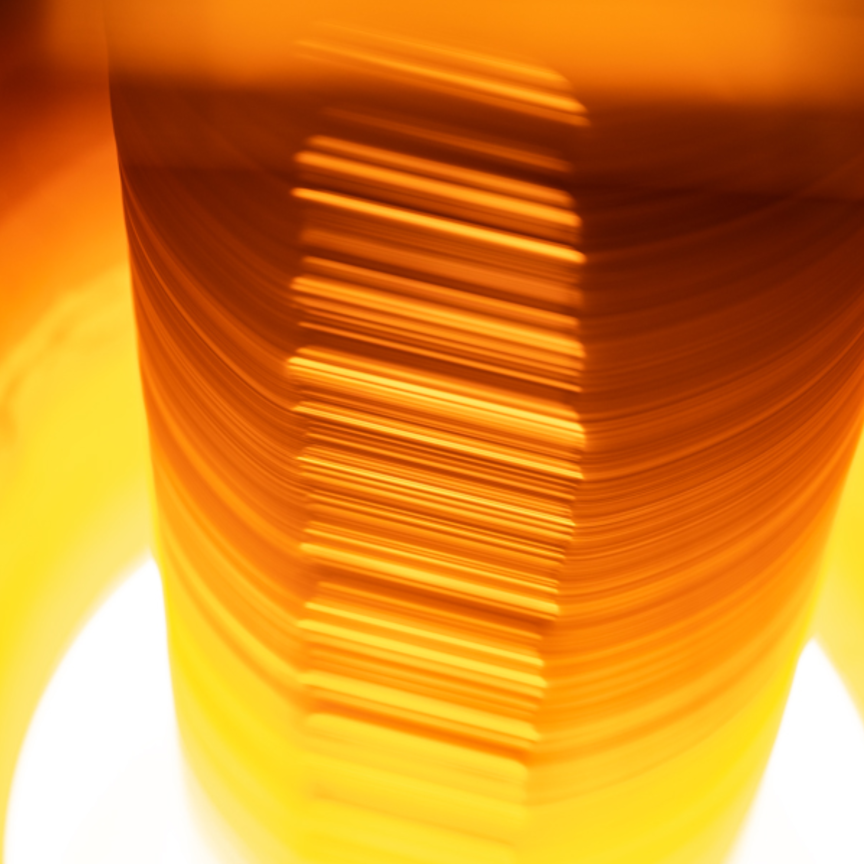
Shown here is the Surrogate Turret Ball of the Airborne Laser, being prepared for Beam Control/Fire Control system integrated testing at Lockheed Martin Space Systems Company's facility at Sunnyvale, California.
President George W Bush withdrew from the Anti-Ballistic Missiles Treaty in 2002, replacing it with the controversial Strategic Offence Reductions Treaty. This opened up the opportunity to develop new missile defence systems. To this end, the United States Air Force awarded Boeing, Northrop Grumman and Lockheed Martin a contract worth $1.1bn to develop the Airborne Laser: a laser, mounted in an aircraft, with enough energy to destroy a missile targeted on the United States.
The Airborne Laser (ABL) will locate, track, and destroy missiles while they are still in the 'boost phase' of their flight, before the missile releases its warheads. Missiles are particularly vulnerable during the boost phase, as the hot exhaust gases present an easily traceable target, and they follow a fixed trajectory. Not only must the system be able to track and trace fast-moving missiles, but the laser used to destroy the missiles must have enough energy to overcome the heavy heat shielding used to protect the missiles from the high temperatures involved in re-entering the earth's atmosphere.

An engineer makes an adjustment to the beam control optics used to stabilise and shape the beam from the Chemical Oxygen Iodine Laser (COIL) of the Airborne Laser.
The system currently being tested is mounted into a Boeing 747-400 jumbo jet. Boeing also supplies the command, control, communications, computers and intelligence equipment. Lockheed Martin has designed and built the beam and fire control system, which consists of controlling optics for the primary laser. The ABL uses a laser-based range finding and tracking system to identify and follow the missile being targeted. The missile is illuminated with light from a high-powered solid-state laser, built by Northrop Grumman, rather than having to rely on natural light. The laser light reflected from the missile is followed by the system that controls the primary laser. This allows the system to identify targets at much greater distances than by conventional methods. Northrop Grumman also supplies the primary weapon system, which will eventually be used to destroy missiles. This is based upon six Chemical Oxygen Iodine lasers. The controlling optics combines the beams from the six laser modules to give a resulting laser with more than a megawatt of power.
Events over the past few years have forced the military establishment, especially in the USA, to rethink its entire concept of what constitute defence and security operations. Strategists are increasingly aware that the most significant threat to many countries comes no longer from enemy states, but from terrorists working in small, isolated cells. To this end, police and military intelligence services often need to carry out both overt and covert surveillance of rooms or premises as part of their duties, capturing sound or images of the area and suspects being surveyed. Overt monitoring, for instance in interrogation rooms, is carried out to capture a verifiable record of the conversations that take place; while covert monitoring must achieve the same objective with the added complications of restricted access to the target premises and avoiding detection of the equipment once the microphone or camera has been deployed.
A further complication, when using microphones either overtly or covertly, is positioning the device so that conversations are recorded irrespective of the position of the people holding a conversation in the room, relative to the microphone. The quality of the recording must be high enough so that individuals can be identified, and the device must be immune to interference from extraneous sources of electromagnetic noise. In covert operations, where the equipment has to be installed in a potentially hostile environment, immunity from detection is another important consideration that must be taken into account.
For such applications, the Security Optical Microphone (SOM) from Winkelmann UK Kingfisher is used by many law enforcement agencies. Unlike traditional microphones, which can be detected using a conventional detector during a counter surveillance sweep, the SOM uses fibre optic technology and an extremely small 6mm diameter head which, when installed, is invisible to all but the most rigorous searches, and it is unaffected by interference (a major source of induced noise in conventional equipment).
The operation of the device is relatively simple: light from a remote LED is transmitted via optical fibre – which can be up to 1km long – on to a reflective membrane, which is mounted a few millimetres from the output of the fibre. Sound waves in the room disturb the sensitive diaphragm, modulating the reflections from it, which in turn modulate the electrical signal from the photo detector, the output of which can be recorded onto a suitable HDD, Flash memory or other storage device. The output is extremely high fidelity; the unit offers a signal to noise ratio in excess of 58dB @ 1kHz 94dB SPL and the microphone is omni-directional. All equipment, other than the microphone unit itself, can be located well away from the area being monitored. The microphone can be embedded in the wall or ceiling or hidden behind existing lights, wall switches or power sockets. The robust fibre optic links can run in existing cable ducts or through any convenient route: over the ceiling, under the floor or though walls. The recordings captured are of sufficient quality to be submitted as evidence in legal proceedings if required.
Photonics and laser technologies are now being used as both components of defence and security systems, and as weapons themselves. As they gain greater acceptance in the inherently suspicious defence industry, the market for such systems is sure to grow exponentially.
Submarine microphone
Microphones are essential components of submarines, both for sonar and listening for the possible presence of enemy vessels. However, traditional electromagnetic hydrophones suffer from drawbacks: they are prone to electromagnetic interference and shocks, and can suffer from 'cross talk' between channels. The sensitivity of traditional microphones to such interference increases rapidly as cable length increases. Koheras is currently working with the Swedish Defence Research Agency Division of Sensor Technology to develop an underwater surveillance system based upon distributed feedback fibre lasers with narrow line widths. These do not suffer from any of the problems associated with traditional electromagnetic hydrophones.
The system consists of an optical fibre laser contained in a mechanical enclosure, designed to enhance acoustic sensitivity. Current electro-optic transducers being used consist of an optical fibre, rather than a fibre laser, wrapped into a coil. However, this arrangement can be bulky – the minimum radius of curvature of the fibre restricts the minimum diameter of the coil (usually to approximately 15mm). In the Koheras system, sound is detected by dimensional changes in the fibre of the laser. These dimensional changes alter the lasing frequency of the light projected from the fibre laser through the fibre. An electro-optical device measures the changes in light frequency and converts the measurements into sound. Unlike the Winkelmann system, the fibre laser microphone does not use a diaphragm to detect sound waves.
The microphone assembly is towed behind the submarine. The microphone is connected to the towing craft via a long optical fibre lead. All the signal processing is carried out on the submarine itself. Because the fibre lasers used have narrow line widths, the signals from many different lasers can be distinguished by the sensor.

